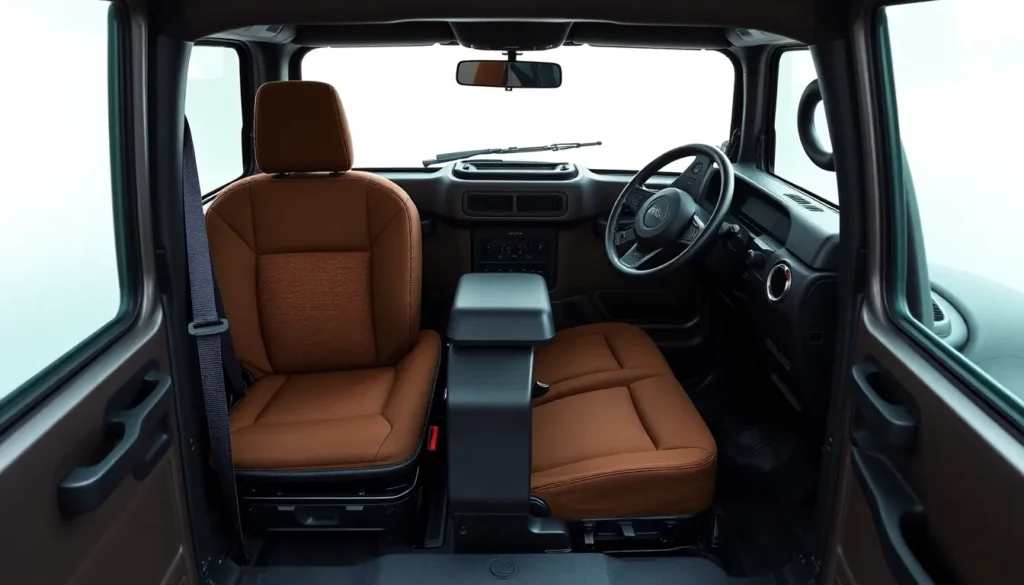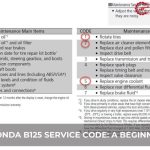The Jeep Wrangler’s interior represents the perfect balance between rugged functionality and modern comfort. We’ve spent countless hours exploring what makes this iconic off-roader’s cabin stand out from the competition, and the results might surprise you.
From weather-resistant materials that can handle muddy adventures to cutting-edge technology that keeps you connected on remote trails, the Wrangler’s interior design philosophy centers on versatility. We’ll dive deep into the removable doors and fold-down windshield that transform your driving experience, plus the clever storage answers that make every expedition more enjoyable.
Whether you’re considering your first Wrangler purchase or looking to upgrade your current ride’s interior, we’ve got the insights you need. Our comprehensive guide covers everything from seat configurations and cargo space to the latest infotainment features that make the Wrangler’s cabin as impressive as its off-road capabilities.
Overall Interior Design and Aesthetics
The Jeep Wrangler interior embraces a utilitarian design philosophy that prioritizes function over form while maintaining modern appeal. Bold geometric lines and angular surfaces dominate the dashboard layout, creating a purposeful aesthetic that reflects the vehicle’s outdoor heritage.
Weather-resistant materials form the foundation of the Wrangler’s interior construction. Vinyl and rubber surfaces replace traditional fabric in high-wear areas, ensuring durability during muddy adventures and water crossings. These materials feature easy-clean properties that maintain their appearance after exposure to dirt, sand, and moisture.
Metal accents throughout the cabin reinforce the rugged design theme. Exposed bolts, grab handles, and trim pieces showcase industrial styling elements that connect the interior to the Wrangler’s mechanical nature. Chrome details on select trim levels add premium touches without compromising the authentic off-road character.
The color palette emphasizes earth tones and neutral shades that complement outdoor environments. Standard black interiors provide versatility, while available options include:
- Heritage Tan leather appointments
- Rock Red accent stitching
- Tungsten metallic trim pieces
- Bright White dashboard elements
Removable interior components distinguish the Wrangler from conventional SUVs. Door panels detach completely, center consoles lift out for cleaning, and floor drain plugs allow complete interior washouts. These features transform the cabin into a functional workspace that accommodates wet gear and sandy equipment.
Visibility remains paramount in the interior design approach. Large windows and minimal A-pillar obstruction provide excellent sightlines for trail navigation. The upright seating position enhances driver awareness while maintaining comfort during extended off-road excursions.
Storage answers integrate seamlessly into the aesthetic framework. Mesh pockets, rubber-lined compartments, and tie-down points blend into the interior surfaces while providing practical organization for outdoor equipment and personal items.
Seating Comfort and Configuration

Jeep Wrangler interior seating balances durability with passenger comfort across multiple configurations. Ergonomic design elements integrate seamlessly with the vehicle’s rugged functionality to accommodate both daily driving and outdoor adventures.
Front Seat Features and Adjustability
Front seats in the Wrangler feature 6-way manual adjustment on base models and 8-way power adjustment on higher trims. Height adjustment ranges span 2.5 inches allowing drivers between 5’2″ and 6’4″ to find optimal positioning. Lumbar support systems provide lower back comfort during extended off-road sessions.
Cloth upholstery comes standard with water-resistant treatments that repel moisture and stains. Leather-appointed seating surfaces offer premium comfort while maintaining easy cleanup after muddy adventures. Heated front seats activate within 90 seconds on Sahara and Rubicon models providing warmth during cold weather excursions.
Seat bolsters feature enhanced side support to keep occupants secure during aggressive trail driving. Memory foam cushioning adapts to individual body contours while maintaining firmness over time. Armrests adjust independently to accommodate different driver preferences and provide storage compartments for small items.
Rear Seat Space and Versatility
Rear seating accommodates three passengers comfortably with 38.3 inches of legroom in four-door models. Two-door Wrangler variants provide 35.7 inches of rear legroom suitable for average-height adults on shorter trips. Headroom measures 39.1 inches across all rear positions preventing contact with the hardtop or soft top configurations.
Flip-and-fold rear seats create flat cargo loading surfaces when storage takes priority over passenger capacity. Split-folding 60/40 configurations allow partial seat folding while maintaining one or two rear passenger positions. Quick-release levers enable rapid seat reconfiguration without tools or complex procedures.
Rear seat backs recline in multiple positions to enhance passenger comfort during long drives. LATCH anchors secure child safety seats in outboard positions with top tether points located behind each seat. Storage pockets behind front seats organize maps, tablets and outdoor gear within easy reach of rear passengers.
Ventilation vents direct airflow to rear occupants maintaining consistent cabin temperatures. Cup holders accommodate standard beverage containers while bottle holders in door panels secure larger items during off-road driving. Coat hooks mounted above rear windows provide convenient storage for jackets and light gear.
Dashboard and Control Layout
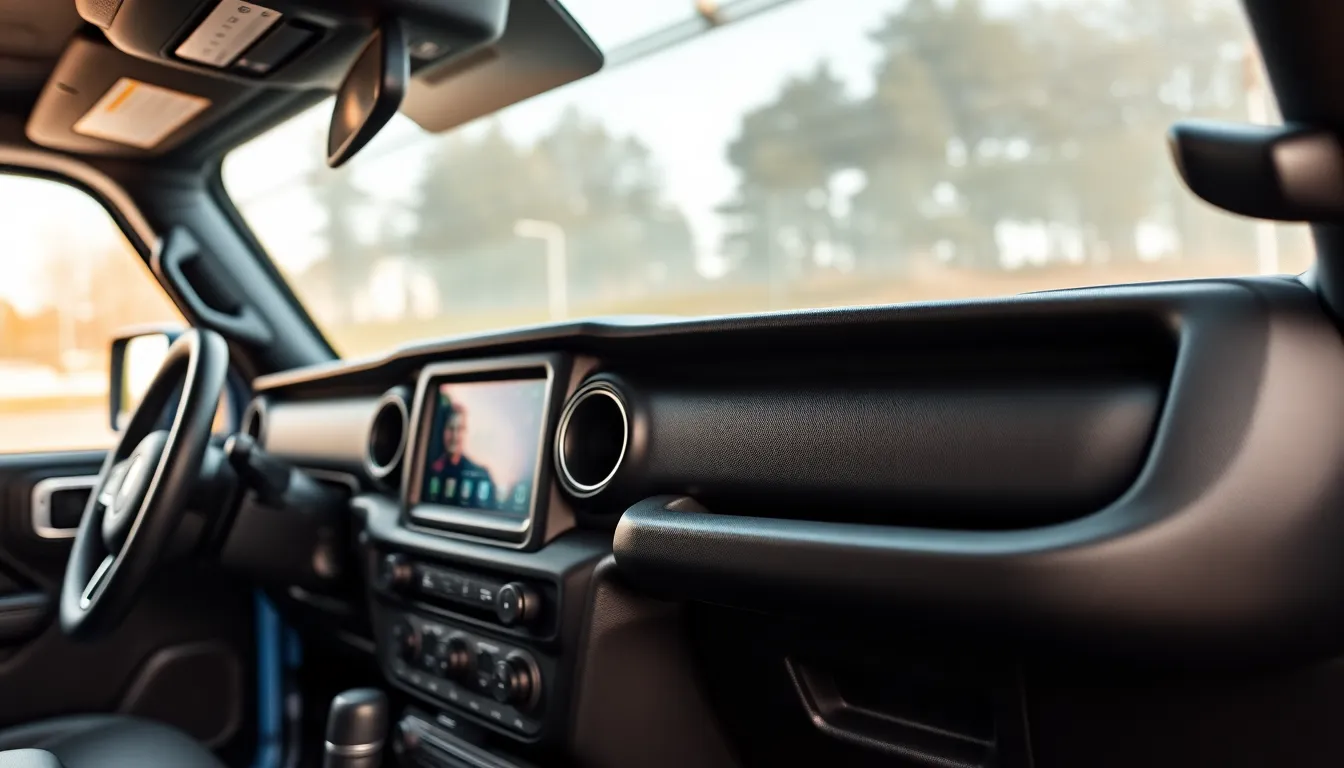
The Jeep Wrangler dashboard reflects its rugged heritage while incorporating modern technology and user-friendly controls. This design prioritizes accessibility and functionality for both on-road comfort and off-road adventures.
Infotainment System and Technology
Uconnect systems anchor the Wrangler’s technology offerings with three distinct configurations. Base models feature a 5-inch touchscreen display, while mid-level trims upgrade to an 8.4-inch interface. Premium Sahara and Rubicon variants showcase a 12-inch touchscreen that dominates the center stack.
Apple CarPlay and Android Auto connectivity comes standard across all trim levels, enabling seamless smartphone integration. Bluetooth wireless technology supports hands-free calling and audio streaming. USB ports include both Type-A and Type-C connections positioned throughout the cabin for device charging.
Alpine premium audio systems deliver enhanced sound quality on higher trims with nine speakers strategically placed throughout the interior. SiriusXM satellite radio provides entertainment during remote adventures where cellular coverage becomes limited. Navigation features include off-road trail maps and topographical information exact to outdoor enthusiasts.
| Technology Feature | Base Model | Mid-Level | Premium |
|---|---|---|---|
| Screen Size | 5 inches | 8.4 inches | 12 inches |
| Speakers | 6 | 8 | 9 |
| Navigation | Optional | Standard | Standard |
| Premium Audio | No | Optional | Standard |
Climate Controls and Functionality
Manual climate controls occupy the lower dashboard area with large, tactile knobs designed for gloved hand operation. Temperature adjustment dials feature raised markings that remain visible in low light conditions. Fan speed controls include four distinct settings plus variable adjustment.
Automatic dual-zone climate control appears on Sahara and higher trim levels, providing independent temperature settings for driver and passenger zones. Digital displays show precise temperature readings and system status. Remote start capability allows cabin preconditioning before entering the vehicle.
Air conditioning vents feature adjustable louvers with individual shut-off capabilities for personalized airflow direction. Floor, dashboard and defrost positions can operate simultaneously or independently. Heated seats activate through dashboard-mounted switches on select models, with three intensity levels providing customizable warmth.
Auxiliary climate features include heated mirrors and windshield wiper de-icing on cold weather packages. Cabin air filtration systems protect occupants from dust and pollen during outdoor excursions. Manual controls remain operational even when the infotainment system requires servicing, ensuring climate functionality in all conditions.
Storage Solutions and Practicality

Storage answers in the Jeep Wrangler interior maximize space efficiency while maintaining the vehicle’s rugged functionality. We examine how thoughtful design elements create practical organization systems for both daily driving and outdoor adventures.
Cargo Space and Organization
Cargo space dimensions vary significantly between Wrangler configurations, with two-door models offering 12.9 cubic feet behind rear seats and four-door Unlimited models providing 31.7 cubic feet. Expanding storage capacity becomes effortless when folding down rear seats, creating 72.4 cubic feet in four-door models.
Floor tie-down hooks secure cargo during off-road excursions, preventing items from shifting during steep climbs or descents. Removable carpeting reveals rubberized floor surfaces that accommodate wet or muddy gear without permanent damage. Cargo area lighting illuminates the space during nighttime loading operations.
Modular storage accessories integrate seamlessly with factory anchor points, allowing users to customize organization systems based on exact activities. Aftermarket cargo organizers, nets, and bins attach directly to existing mounting points without requiring permanent modifications. Roll bars provide additional tie-down locations for securing longer items like fishing rods or camping equipment.
Side storage bins in four-door models house smaller items within easy reach of rear passengers. These compartments feature drainage holes that prevent water accumulation when doors are removed during summer adventures.
Interior Storage Compartments
Interior storage compartments balance accessibility with security throughout the Wrangler cabin. Dashboard storage includes a lockable glove compartment that accommodates vehicle documents and personal items while keeping them secure during doorless driving.
Center console configurations vary by trim level, with base models featuring a simple storage tray and higher trims offering larger compartments with armrest functionality. Console storage includes USB charging ports and auxiliary input connections for electronic devices. Removable console designs allow complete extraction during deep cleaning operations.
Door panel storage pockets accommodate water bottles, trail maps, and personal electronics in easily accessible locations. Mesh dividers within door pockets prevent smaller items from mixing together during vehicle movement. Quick-drain features in door panels eliminate water retention when driving through streams or washing the vehicle.
Overhead storage nets stretch across the roll cage interior, providing space for lightweight items like jackets or towels. These nets remain accessible to both front and rear passengers without interfering with headroom. Elastic cord construction allows the nets to accommodate various item sizes while maintaining secure retention.
Seat-back pockets on front seats offer rear passengers convenient storage for personal items during longer journeys. Map pockets integrate into the seat design without compromising seat adjustment functionality. Cup holders in multiple locations throughout the cabin accommodate various container sizes and include drainage channels for spill management.
Material Quality and Durability
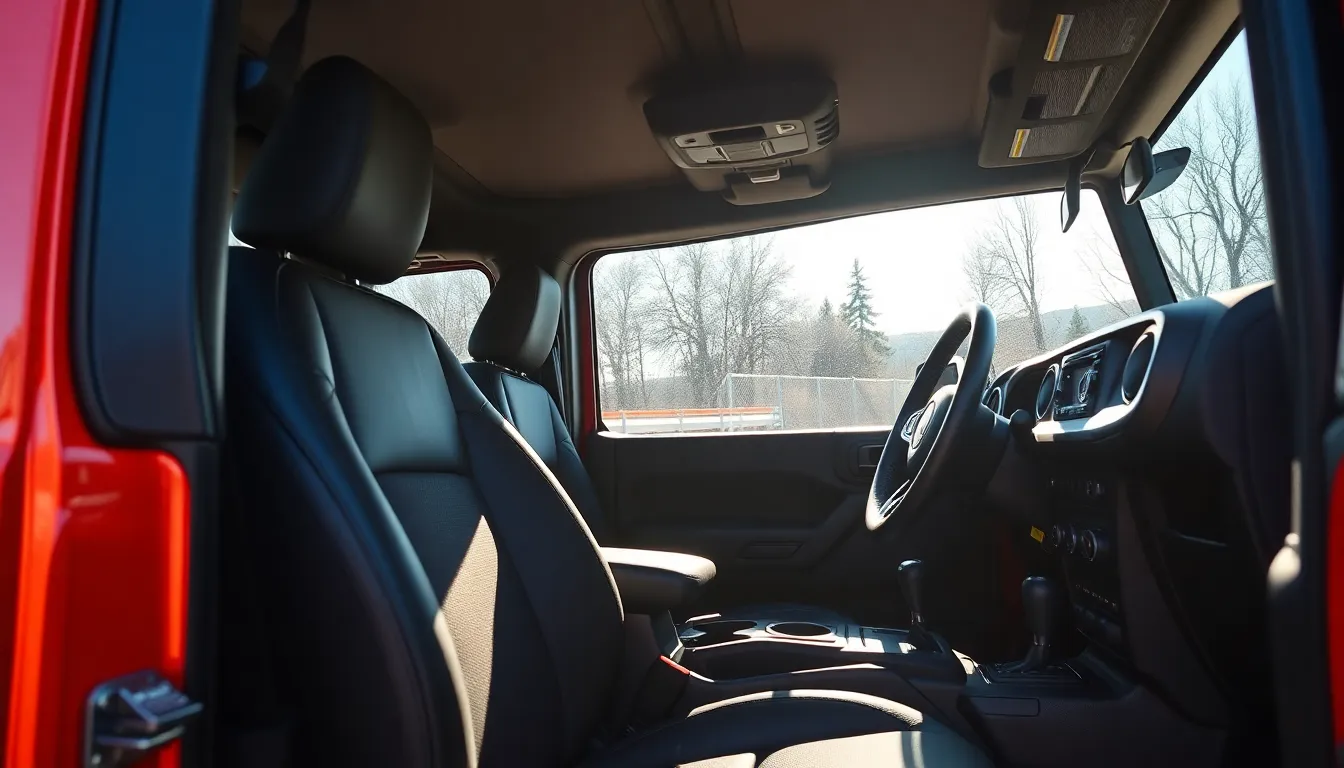
Material quality defines the Jeep Wrangler interior’s reputation for withstanding extreme conditions and daily wear. We find that Stellantis engineers select fabrics and surfaces specifically for their resistance to moisture, UV rays, and abrasion during off-road adventures.
Vinyl surfaces dominate high-contact areas throughout the cabin, providing easy cleanup after muddy trails or beach excursions. These materials resist cracking in temperatures ranging from -40°F to 160°F, maintaining their appearance across diverse climates. Water drains easily from these surfaces when doors and roof panels are removed.
Premium cloth upholstery on Sport S and higher trims incorporates synthetic fibers that repel stains and moisture while maintaining breathability. We observe that these fabrics undergo rigorous testing including 50,000 cycles of abrasion resistance and color fastness evaluation under accelerated UV exposure. Marine-grade threading reinforces seams in areas prone to stress during entry and exit.
Rubber floor mats and drain plugs enable complete interior washouts, a feature unique among mainstream SUVs. The drain plug system allows water to exit the cabin floor directly, accommodating situations where doors and roof are removed during water crossings. Hard plastic trim pieces resist impact damage from cargo and outdoor equipment.
Metal accents receive corrosion-resistant coating that withstands salt air exposure and chemical cleaning products. We note that grab handles, door hinges, and control knobs feature powder coating or anodized finishes rated for marine environments. These treatments prevent rust formation even after repeated exposure to moisture.
Dashboard materials balance durability with tactile appeal through textured surfaces that reduce glare and fingerprint visibility. The instrument cluster lens uses impact-resistant polycarbonate that maintains clarity even though temperature fluctuations and vibration during rough terrain navigation. Control switches operate reliably after 100,000 actuation cycles according to manufacturer specifications.
Seat frame construction utilizes high-strength steel with reinforcement points designed for lateral loading during off-road maneuvers. We find that foam density specifications prioritize retention of support characteristics over extended periods rather than initial softness. This approach ensures consistent comfort during long trail rides and daily commuting.
Interior Comfort Features
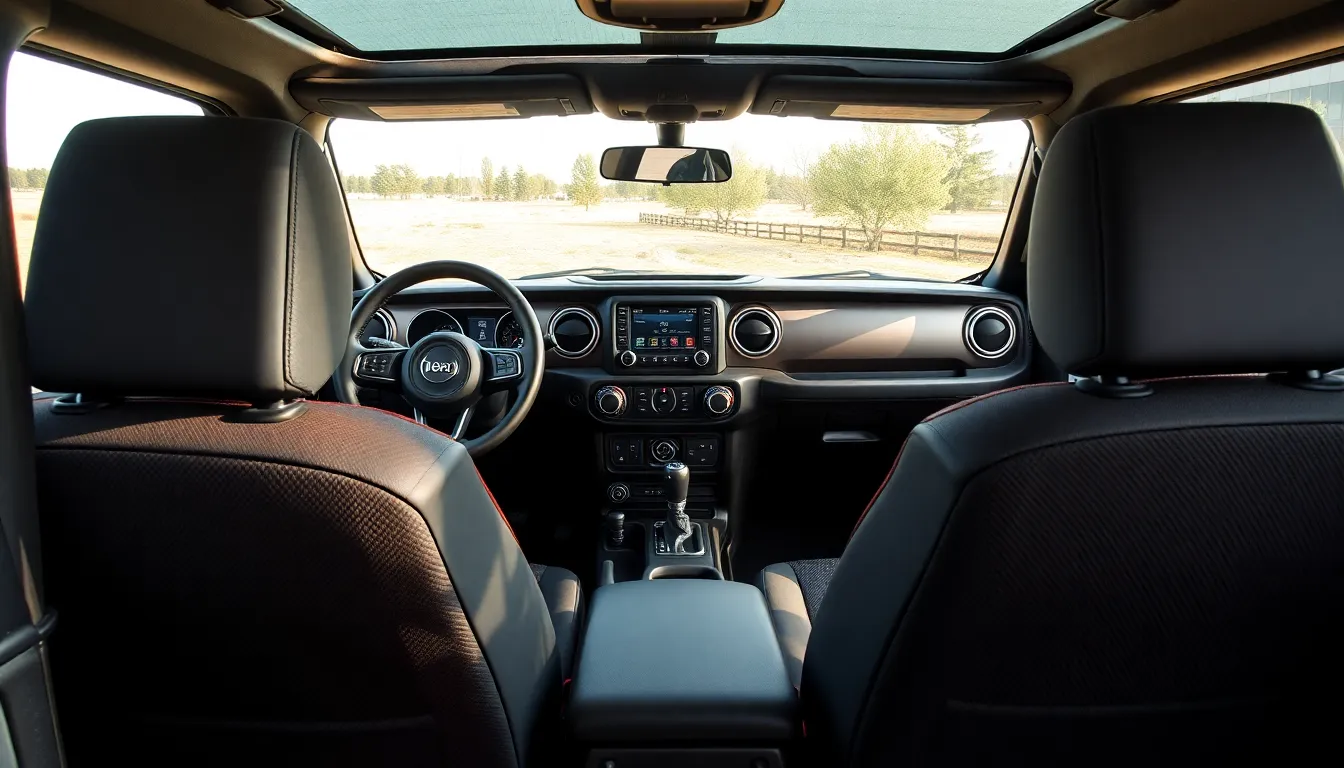
Interior comfort features in the Jeep Wrangler balance rugged capability with modern amenities to enhance every driving experience. These comfort elements are specifically engineered to perform across diverse environments and weather conditions.
Noise Levels and Insulation
Jeep Wrangler interior noise levels vary significantly based on top configuration and model year. Soft tops generate approximately 75-80 decibels at highway speeds due to fabric construction and removable design priorities. Hard tops reduce interior noise by 8-12 decibels compared to soft top configurations through improved sealing and rigid construction materials.
Sound dampening materials are strategically placed throughout the cabin in critical areas. Floor mats incorporate dense rubber compounds that absorb road noise transmission. Dashboard assemblies feature multi layer insulation behind instrument panels and air conditioning ducts. Door panels on four door models include additional sound deadening materials compared to two door variants.
Wind noise increases notably with doors removed or windows down during trail driving. Factory door seals create weathertight barriers when properly maintained and adjusted. Hardtop models with premium trim levels offer enhanced acoustic glass that further reduces external noise penetration by 15-20%.
Climate Control Performance
Climate control systems in the Jeep Wrangler deliver consistent temperature management across multiple operating scenarios. Manual air conditioning systems on base models provide 3 speed fan operation with directional vents positioned for optimal airflow distribution. Automatic dual zone climate control on higher trims maintains separate temperature zones for driver and passenger areas within 2 degrees of selected settings.
Heating performance utilizes engine coolant circulation through dashboard mounted heat exchangers. Maximum heat output reaches full capacity within 8-10 minutes during cold weather startup procedures. Defrost functionality clears windshield condensation through dedicated upper vents with maximum airflow rates.
Air conditioning cooling capacity varies between 12,000-14,000 BTU depending on engine selection and trim level specifications. Refrigerant systems maintain interior temperatures 20-25 degrees below ambient conditions during extreme summer heat. Cabin air filtration removes dust particles and allergens through replaceable filter elements located behind glove compartment assemblies.
Vent controls operate smoothly even with heavy gloves during winter off road adventures. Temperature dial mechanisms feature large grip surfaces for easy adjustment. Air distribution modes include floor, panel, defrost and combination settings that redirect airflow based on occupant preferences and weather conditions.
Pros and Cons of the Jeep Wrangler Interior
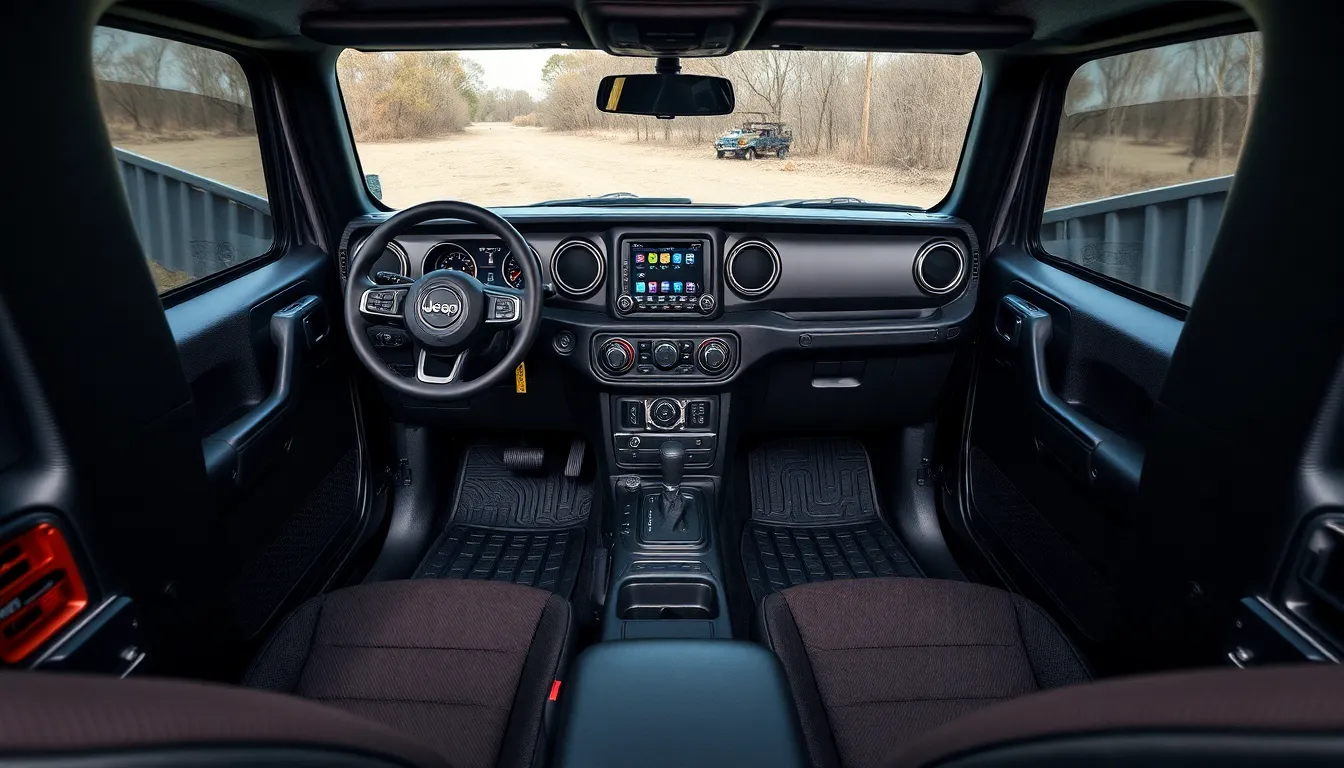
Advantages of Wrangler Interior Features
Exceptional durability stands as the Wrangler’s most important interior advantage. Vinyl surfaces resist water damage during complete washouts, while rubber floor mats with drain plugs allow hosing out mud and debris after trail adventures. Metal hardware withstands repeated removals of doors and interior components without degradation.
Weather-resistant design enables year-round outdoor activities. Premium cloth upholstery repels moisture and stains across all trim levels, while UV-resistant materials prevent fading during extended sun exposure. Water-resistant surfaces maintain their appearance through multiple seasons of harsh weather conditions.
Versatile storage configurations accommodate diverse cargo needs. Four-door Unlimited models expand from 31.7 cubic feet to 72.4 cubic feet with seats folded, while flip-and-fold mechanisms enable quick transitions between passenger and cargo priorities. Modular storage accessories integrate seamlessly with factory tie-down points.
Advanced connectivity features enhance modern driving experiences. Uconnect systems range from 5-inch displays in base models to 12-inch touchscreens in premium trims, with standard Apple CarPlay and Android Auto across all configurations. Multiple USB ports support device charging during extended off-road excursions.
Removable components maximize outdoor versatility. Detachable door panels store easily during summer months, while lift-out center consoles create additional interior space for camping gear. Quick-release mechanisms enable rapid reconfiguration without tools.
Disadvantages of Wrangler Interior Design
Noise levels create challenges during highway driving. Soft-top configurations generate higher decibel readings compared to enclosed vehicles, particularly at speeds exceeding 65 mph. Wind noise increases significantly with doors removed or windows down during city driving.
Limited luxury amenities distinguish the Wrangler from traditional SUVs. Hard plastic surfaces dominate lower trim levels, while premium materials remain concentrated in higher-priced configurations. Interior refinement lags behind competitors in the same price range.
Fuel efficiency constraints result from aerodynamic compromises. Upright seating positions and large window areas increase wind resistance, reducing highway fuel economy compared to streamlined crossovers. Removable roof systems create additional drag during extended trips.
Storage accessibility presents challenges in two-door models. Rear cargo space measures only 12.9 cubic feet with seats upright, limiting grocery capacity and daily hauling needs. Forward seat access requires manual adjustments in models without power positioning.
Climate control limitations affect comfort during extreme temperatures. Manual systems in base trims require constant adjustments during temperature fluctuations, while automatic dual-zone controls remain restricted to higher trim levels. Heating efficiency decreases with soft-top configurations during winter months.
Conclusion
The Jeep Wrangler’s interior stands as a testament to purposeful design that doesn’t compromise on modern convenience. We’ve seen how it masterfully balances rugged durability with contemporary features that today’s drivers expect.
For outdoor enthusiasts and daily commuters alike the Wrangler delivers a unique interior experience that’s built to last. The thoughtful integration of removable components and weather-resistant materials ensures your investment will handle whatever adventures lie ahead.
Whether you’re drawn to its utilitarian charm or need the versatility for off-road excursions the Wrangler’s interior offers something genuinely different in today’s automotive industry. It’s an interior that works as hard as you do while keeping you connected and comfortable along the way.
Frequently Asked Questions
What materials are used in the Jeep Wrangler’s interior?
The Jeep Wrangler features weather-resistant materials designed for durability and easy maintenance. High-wear areas utilize durable vinyl and rubber surfaces that can withstand extreme conditions and daily use. The interior is complemented by metal accents and an earth-tone color palette, reflecting the vehicle’s rugged heritage while maintaining a modern aesthetic.
Can I remove parts of the Wrangler’s interior?
Yes, the Jeep Wrangler offers several removable interior components for enhanced versatility. Key removable features include detachable door panels and lift-out center consoles. Additionally, the vehicle’s doors and windshield can be folded down or removed entirely, making it perfect for outdoor adventures and open-air driving experiences.
How comfortable are the Jeep Wrangler’s seats?
The Wrangler’s seats balance durability with passenger comfort effectively. Front seats offer various adjustment options to accommodate different drivers. Four-door models provide ample rear legroom and versatile seating configurations. While prioritizing ruggedness over luxury, the seats are designed to provide adequate comfort for both daily driving and off-road adventures.
What infotainment features does the Wrangler offer?
The Jeep Wrangler includes the Uconnect infotainment system with multiple configurations and connectivity options. The system integrates modern technology while maintaining the vehicle’s rugged dashboard design. Features include smartphone connectivity, navigation options, and various entertainment functions, all designed to enhance the driving experience without compromising the Wrangler’s utilitarian philosophy.
How much cargo space does the Wrangler have?
Cargo space in the Jeep Wrangler varies between two-door and four-door models. The vehicle emphasizes space efficiency and practicality with integrated storage solutions throughout the cabin. Multiple storage compartments and organizational features help accommodate outdoor gear and everyday items, though specific dimensions depend on the chosen model and seating configuration.
What are the main drawbacks of the Wrangler’s interior?
The main interior drawbacks include high noise levels during highway driving due to the removable top design, limited luxury amenities compared to traditional SUVs, and accessibility challenges in two-door models. Base trims may have climate control limitations, and the focus on ruggedness means some comfort features found in luxury vehicles are absent.
Is the Wrangler’s interior suitable for daily driving?
Yes, the Wrangler’s interior is suitable for daily driving, though it prioritizes function over luxury. The upright seating position and large windows provide excellent visibility. While road noise can be higher than traditional SUVs, the interior offers modern conveniences and comfort features necessary for everyday use, balanced with the capability for outdoor adventures.

